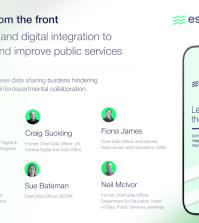Top trends in 2023: what will governments prioritise in the year ahead?

As the calendar changes from 2022 to 2023, the mammoth challenges faced by governments only grow bigger. From dealing with a looming global recession to decarbonising economies, the key items on the agendas of public services around the world are no easier to tackle this year than last. Here is Global Government Forum’s guide to the top trends affecting governments, along with insight into how departments and agencies will respond
The Collins English Dictionary’s word of the year for 2022 was permacrisis, defined as “an extended period of instability and insecurity”, and there is little sign that we are in for more settled sailing in 2023. The inflation and cost of living crisis in many countries could become a full blown global recession. The need for governments to embed action to tackle climate change grows more urgent. Add in the continuing need to improve public services for citizens, and the in tray for civil and public servants in 2023 is daunting.
Here’s Global Government Forum’s exclusive rundown on the major issues shaping the year ahead.
Economy and finance
The lights on the global economic dashboard are flashing red. Earlier this month, the World Bank cut its economic forecast for many countries, warning that global growth is slowing sharply in the face of elevated inflation, higher interest rates, reduced investment, and disruptions caused by Russia’s invasion of Ukraine. The bank now forecasts that the global economy will grow by just 1.7% in 2023, with specific national forecasts revised down for 95% of advanced economies and nearly 70% of emerging market and developing economies.
This will have consequences for governments. Economic slowdowns require additional government spending, and low growth also results in lower tax revenues, impacting funding for public services.
Governments will have to respond, and most will be able to draw upon their recent experience of responding to the economic crisis caused by the coronavirus pandemic – an event which also changed expectations among citizens of what government could do.
But we also have the fiscal impact from those support programmes implemented during COVID-19. And after bond markets seemingly slept for many years following the 2007-08 financial crisis, the UK’s brief experiment with the ‘Trussonomics’ policies of former prime minister Liz Truss has shown that they are now awake and, post-COVID, will not accept increases to government borrowing to continue over five year forecast periods without plans to repay them.
Read more: Can new prime minister Rishi Sunak bring stability to UK?
The UK’s experience, which led to a spike in how much government pays to borrow money, was a shot across the bows of finance ministries, and it would not be a surprise to see countries respond to the crisis with what Truss dismissed as orthodoxy – controlling spending to keep public finances under control, and letting a slowing economy bring down inflation.
All in all, it will be a difficult year for many, including public servants. Services will not always get the funding they need, and staff themselves will face pay restraint. This comes at a time when governments are facing recruitment difficulties, which are particularly acute in vital areas like digital skills, cyber security and artificial intelligence. In 2022, countries as far apart as Australia and Belgium refer to governments being in a war for talent, and it is unlikely to be won conclusively in 2023 – even if cooling economies take some of the heat out of labour markets.
Government resilience
Linked to how governments respond to economic slowdown is the challenge of building resilience in the public sector – a requirement also illustrated amply by COVID-19, and increasingly by climate-related emergencies.
These crises show how crucial it is for governments to be able to respond quickly to change, and many are now working to reflect this in their policies.
In the UK, for example, a new resilience framework has been published, which is built around three fundamental principles: the need for a shared understanding of risks; an increased focus on prevention and preparation; and the development of a whole-of-society resilience approach.
The framework shows the scale of the challenge that the UK government – and indeed all governments – face. It pledges that by 2030, government’s understanding of national and local risks will be dynamic rather than static, driven by data and insight where appropriate, and informed by the best expertise and experience. But there is a long time between now and then, when – as we have seen – risks can appear at pace. There is also an aim that, within the UK government, there will be clear ownership of all risks, including complex and catastrophic risks, and in every part of the resilience system, responsibilities and accountability will be clear, coordinated, and coherent.
The framework is a window into how governments are absorbing the lessons of the pandemic – and how they are aiming to move from spending most money on responding to and recovering from emergencies to increased prioritisation of investment in prevention and preparation. And the UK is not the only country taking this approach – the Government of Canada’s Emergency Management Strategy also plans an “increased focus on whole-of-society disaster prevention and mitigation activities”, and in the US, the federal government has developed a resilience framework specifically related to the impacts of climate change.
Every year in our age of permacrisis is going to test this balance, but 2023 is particularly crucial in understanding how the resilience frameworks mentioned are bedding in and how lessons from the pandemic are being absorbed. This will crossover into responses to the increasing frequency of climate-related events – and we will touch on sustainability in the next section.
Sustainability and net zero
The challenges of dealing with climate change are becoming more acute. As was made clear at COP27 held late last year, we are now at “the turning point where the world came together and demonstrated the requisite political will to take on the climate challenge through concerted, collaborative and impactful action”. At the conference in Egypt, participants pledged to turn agreements and pledges into projects and programmes, but there are still gaps between the ambitions of net zero – signed up to by 133 countries representing 80% of the world’s population – and the action needed to achieve it.
That is why a document published by the UK government earlier this month was so interesting. The Net Zero Review was an independent, but government commissioned, report looking at how the UK government could make the transition to net zero.
It illuminated the scale of the problem, with government action required in eight areas: using infrastructure to unlock net zero; creating sustainable governance structures; backing businesses to go green; catalysing local action; increasing transparency and engaging people; delivering cleaner, cheaper, greener homes; capitalising on international leadership; and how to set the country up for 2050 and beyond.
Among its lessons for governments – and the report author, former UK minister Chris Skidmore said he hoped the review provided “international leadership in setting out a comprehensive roadmap towards a net zero future” – was the recommendation that a cross-government office be established to coordinate net zero delivery and place it at the heart of government thinking.
Individual programmes – whether cutting across departments or the responsibility of one individual authority – should also have separate delivery arms to oversee long-term decarbonisation programmes, the report said.
Other governments are thinking about and developing their own mechanisms for delivering net zero. And as UK civil service chief operating officer – and Innovation 2023 champion – Alex Chisholm has previously warned, reaching net zero will require new and different skills in public and civil services.
“This requires us to see through multiple phases – being able to make this scale of changes, and to keep those in place is a new type of challenge for the civil service,” he said in 2021. “We’re trying to make sure that our institutional capacity for sustaining that is greater.”
This is a challenge that all governments face, and something that many governments are working on.
Digital and transformation
Digital capabilities underpin the delivery of modern public services by governments, and driving progress on improving how technology delivers for government is a key task.
We know that many areas of government faced great change during the pandemic, with some services moving online in response to the need to maintain social distancing, and new delivery capabilities around government payments developed at speed.
However, as a paper by GGF knowledge partner Visa has highlighted, and which we will explore in an upcoming webinar, as the COVID crisis recedes, so has the urgency to digitise, with pre-existing cash-based and in-person payment systems becoming the norm once more.
Register now: Future proofed: how government can create next-generation disbursement schemes
This return to the old way of doing things has been noticed across the globe. Former Canadian cabinet secretary Michael Wernick told GGF about what he calls a sudden “snapback” in the public mood towards the public service in Canada, where people went from appreciating frontline responders in the pandemic to adopting a “grumpy sullenness” towards public service problems in areas such as passports and immigration processing afterwards.
The risk is that this snapback also applies to how government do things – that now the immediate jolt to reform has receded, digital reform will move to the backburner.
Interestingly, this is a phenomenon that has already happened. In our Digital Leaders study, former UK digital chief Kevin Cunnington spoke to seven national digital leaders to identify the biggest barriers to successful digital reforms, and the snapback from digital funding was one of them. The study found that having invested large sums in digital skills, strategies and services several years ago, there was reticence to do so again, even as the technology required for modern services in areas like digital ID changed. This has left many public services dependent on ageing, outdated legacy systems – and in our second digital leaders report later this year, we will be looking at what impact this has had on public services. Because until these systems are replaced or renewed, the opportunities for true digital transformation remain limited – while the costs and complexity of ongoing maintenance, licensing and cybersecurity continue to rise.
And it is not only the leaders who notice these things. Global Government Forum carried out the UK Civil Service Digital Skills Report, supported by Google Cloud, with more than 1,000 responses from different grades of the civil service.
When asked to name the top issues that are significantly holding them back from using digital to improve public services, officials named legacy technology that is no longer fit for purpose, and budget constraints/lack of funding as the top issues.
Read more: UK civil servants highlight barriers to digital transformation in government
Other significant factors highlighted by the 1,006 respondents to the survey included a lack of fit-for-purpose civil service funded training opportunities, and a lack of knowledge at the strategic level in government.
And it is an issue that the UK government is aware of. In the foreword to the report, Megan Lee, the chief executive of the Central Digital and Data Office (CDDO), said “I don’t underestimate the challenges we face when it comes to attracting and retaining top of the market digital talent in a fiercely competitive environment, or the benefits that could be reaped for the public if we are to succeed in building digital skills at scale”.
She added that in an increasingly challenging external environment, the civil service will need to work smarter and faster to deliver great services to the public, and to deliver policies that are precise and impactful.
And this is the key challenge. There is no way to transform government that does not involve digital, but from skills to funding, there are a number of limiting factors that are stopping governments from making the most of what is possible. And this gulf could get even wider, as automation and artificial intelligence technologies become more widespread. As one respondent to the digital skills survey told us, it’s really important that public servants have the knowledge to understand in principle what the tech does, so that they can identify where technologies like artificial intelligence, automation and cloud computing can drive improvement.
“I don’t need to know how to use it,” they said. “I just need to know what it does, so I can say, ‘that would help me’”.
Making progress on building this knowledge across government will be key to making sure that governments are ready for the future – in 2023 and beyond.
Read more: Sage advice for civil servants: the best bits of Leading Questions Series 2
What are the key trends affecting your work in government? Please let us know below, or get in touch to [email protected]





















